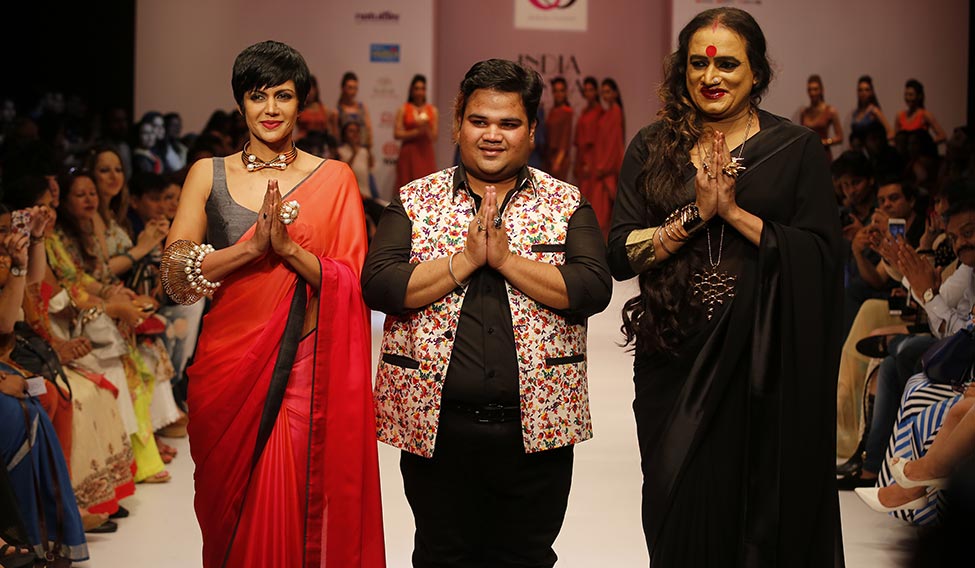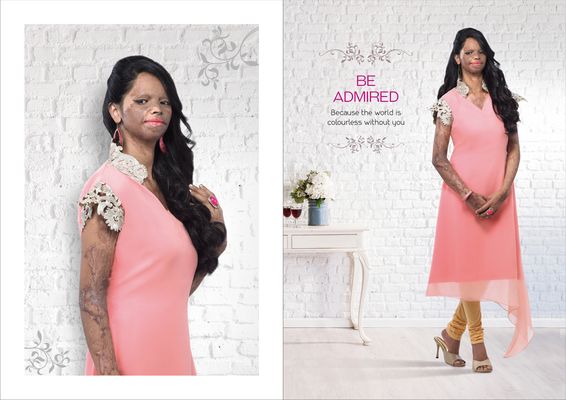American fashion designer Anne Klein once said, “Clothes aren’t going to change the world. The women who wear them will.” Several Indian designers seem to be in agreement with her. This year, as they launched their fashion lines, they kept social causes in mind and put outcasts on the ramp.
Kerala-based fashion designer Sharmila Nair chose transgenders to model for her Hubli cotton sari collection named Mazhavil (rainbow in Malayalam). “Transgenders are always projected in a bad light,” said Nair. “I wanted to break the barrier and project them beautifully, so that they, too, get the respect and support they deserve.”
To find the models, she went to Queerala, an organisation that supports sexual minorities. Jijo Kuriakose, who heads the organisation considered it a great opportunity for the community and introduced her to Maya Menon and Gowri Savithri. “They wore my collection,” Nair said.
An English graduate and yoga practitioner, Menon, 27, had fears that the decision to use transgenders as models would damage Nair’s career. “I thought it was a courageous move, and the concept excited me. But I wasn’t sure how well the collection would connect with her usual buyers. If they did not buy the saris, it could have jeopardised her career,” said Menon.
Nair, however, did not worry about it as her intention was to redefine beauty. “I wanted to bring transgenders into focus and give them a platform to embrace their beauty,” she said. A short video she made about her transgender models won praise in India as well as abroad. “It was a game-changing moment for us,” she said. “A lot of foreign clients came forward. Some bought the saris for their worth, while others bought them to support the cause. College students and youth supported the initiative wholeheartedly.”
 Designer Akassh K. Aggarwal (centre) chose transgender activist Laxmi Narayan Tripathi (right) to walk the ramp with Mandira Bedi for his spring/summer collection in April.
Designer Akassh K. Aggarwal (centre) chose transgender activist Laxmi Narayan Tripathi (right) to walk the ramp with Mandira Bedi for his spring/summer collection in April.
Even though her line did not connect well with the older buyers, Nair said her initiative helped a lot of transgenders embrace their sexuality. “They wanted to be heard and accepted the way they are. People’s attitude also changed and we could see a sense of affection and acceptance.”
At India Runway Week 2016, in April, Delhi-based jewellery designer Akassh K. Aggarwal celebrated gender and femininity by choosing transgender activist Laxmi Narayan Tripathi to walk the ramp with the celebrity Mandira Bedi for his spring/summer collection, The Coeur Collectives. “The idea was to create a companionship between the two passive genders to take a stand in front of the dominant male gender,” said Aggarwal. “I chose Mandira because of her iconic status in her field, where she redefined a male-dominated area like cricket. Laxmi, on the other hand, represents the third gender, which is struggling for identity. I wanted to bring out the message of gender equality.”
 The brand Viva N Diva chose acid attack survivor Laxmi Saa as its model
The brand Viva N Diva chose acid attack survivor Laxmi Saa as its model
This isn’t the first time that Aggarwal has chosen a social cause as a theme for his collection. All six of his shows have highlighted a social cause. “Whenever I do a runway show, I plan to do it as a canvas. My idea is to pass on the thought to the people,” he said.
The show won hearts, but change is still a long way off, said Tripathi. Even though designers are taking up such initiatives and sensitising the public, she said, it is society’s responsibility to bring about change. “It, obviously, will take a long time,” she said.
The brand Viva N Diva struck a chord when it chose an acid attack survivor, Laxmi Saa, as the model for its collection and its campaign, Face of Courage. “People were sceptical about the idea,” said its founder, Rupesh Jhawar. “Some said, ‘Why don’t you donate the money instead’. But we felt that by giving a donation, we would not be able to highlight the cause. The survivors will continue to be dependent on others. That’s why we signed Laxmi as a model [through the NGO Stop Acid Attacks] so that she could gain respect and be rewarded for her efforts.”
Saa was ecstatic when she got the offer. Through this platform, she thought, people would read about stories of acid attack survivors and give them love and respect, instead of sympathy. The campaign however, did not receive any attention in India till the media abroad broke the story.
“Internationally, the campaign got noticed and was applauded. That changed our lives,” said Saa. “Almost all the survivors in the NGO got the opportunity to be part of ramp shows. Several private companies started inviting us for talk shows and to be runway models for their events. It opened doors for us. People wanted to know about our lives. Job opportunities eventually increased.”
In August, the fashion brand aLL redefined beauty in another manner at the Lakme Fashion Week Autumn/Winter 2016. It put up a plus-sized show, after auditioning large people and keeping professional models out. Through this big move, aLL celebrated the message that fashion caters to all body types.






